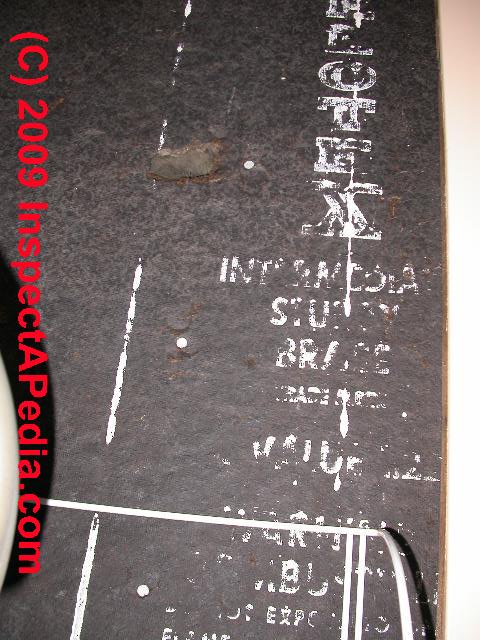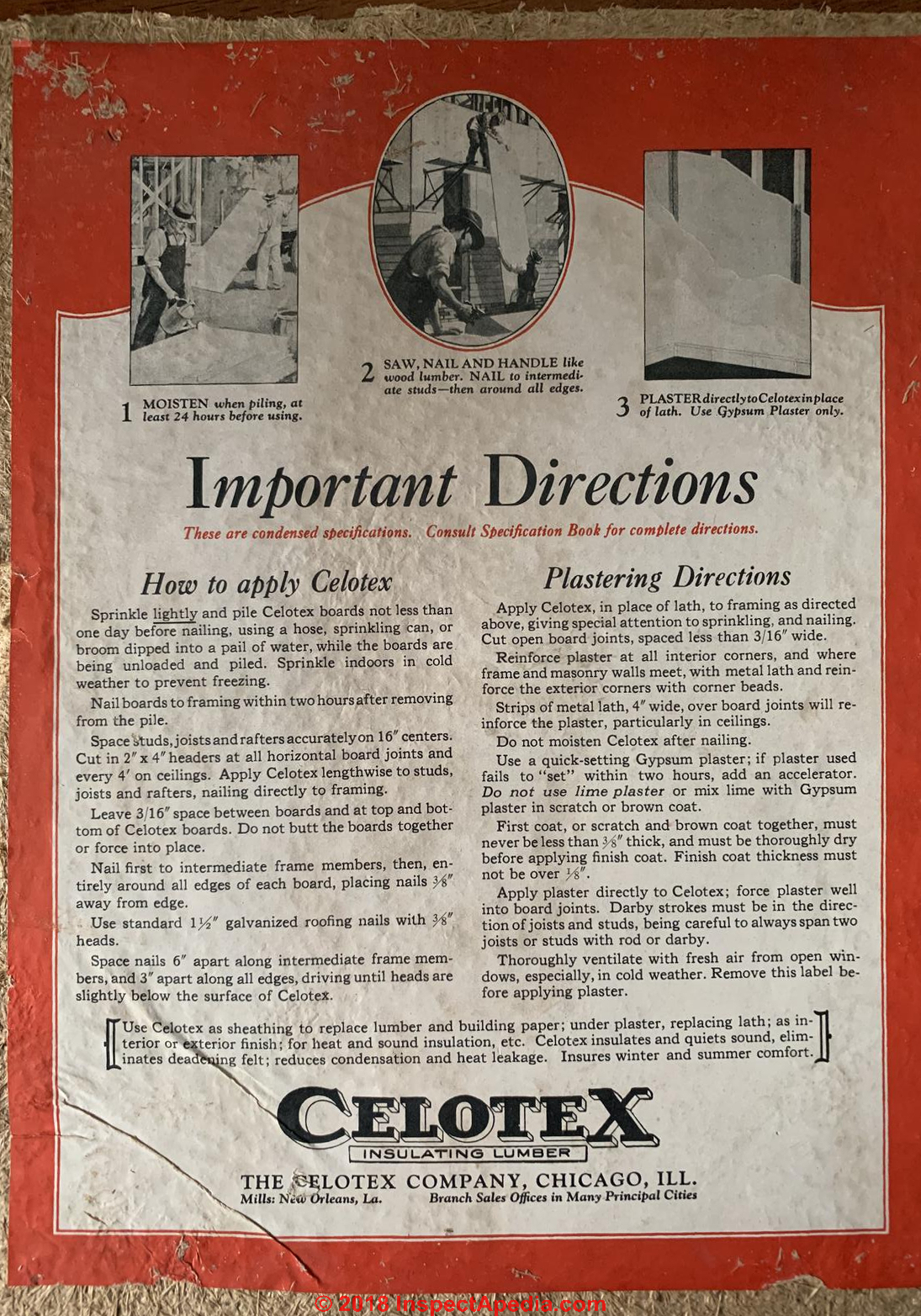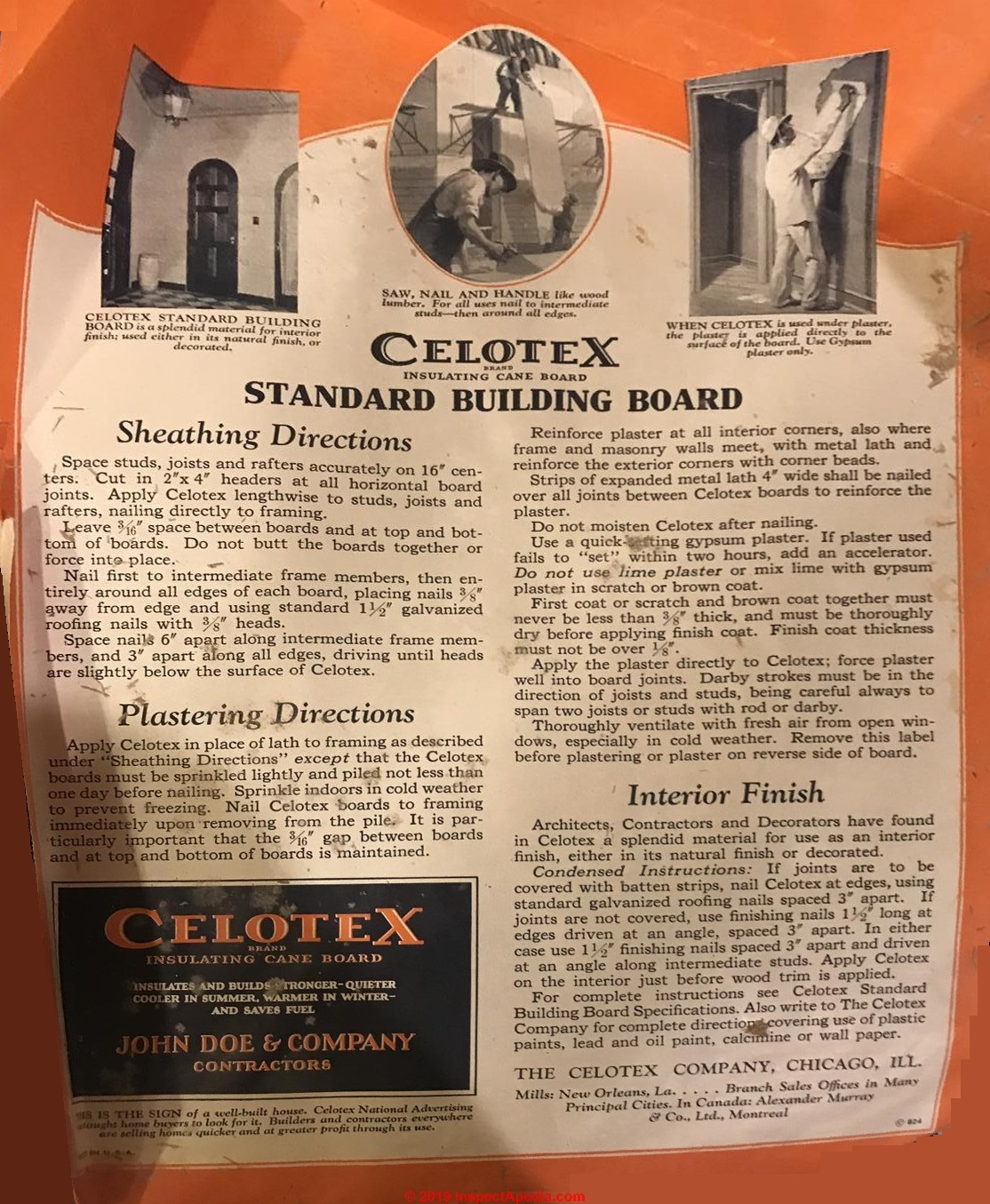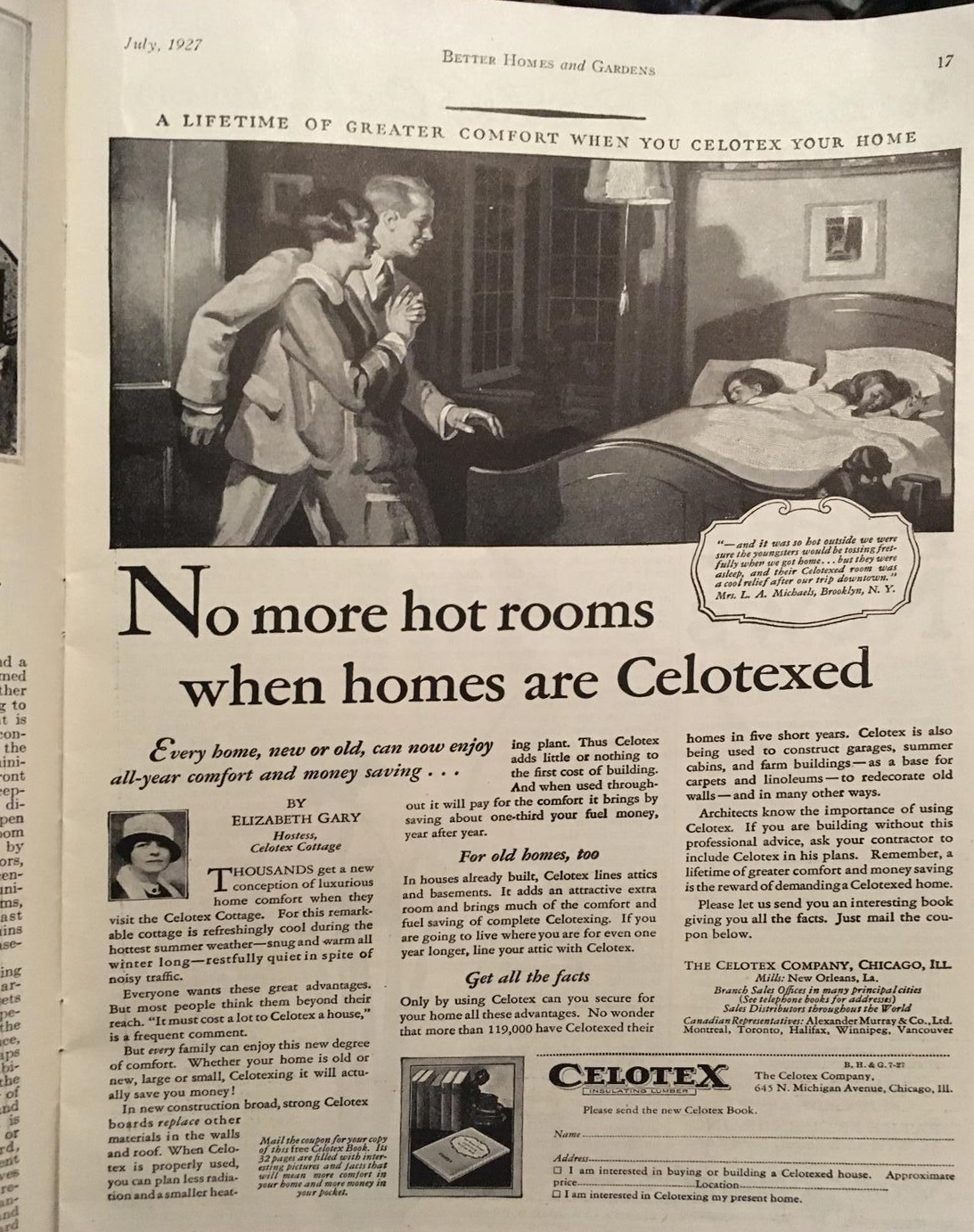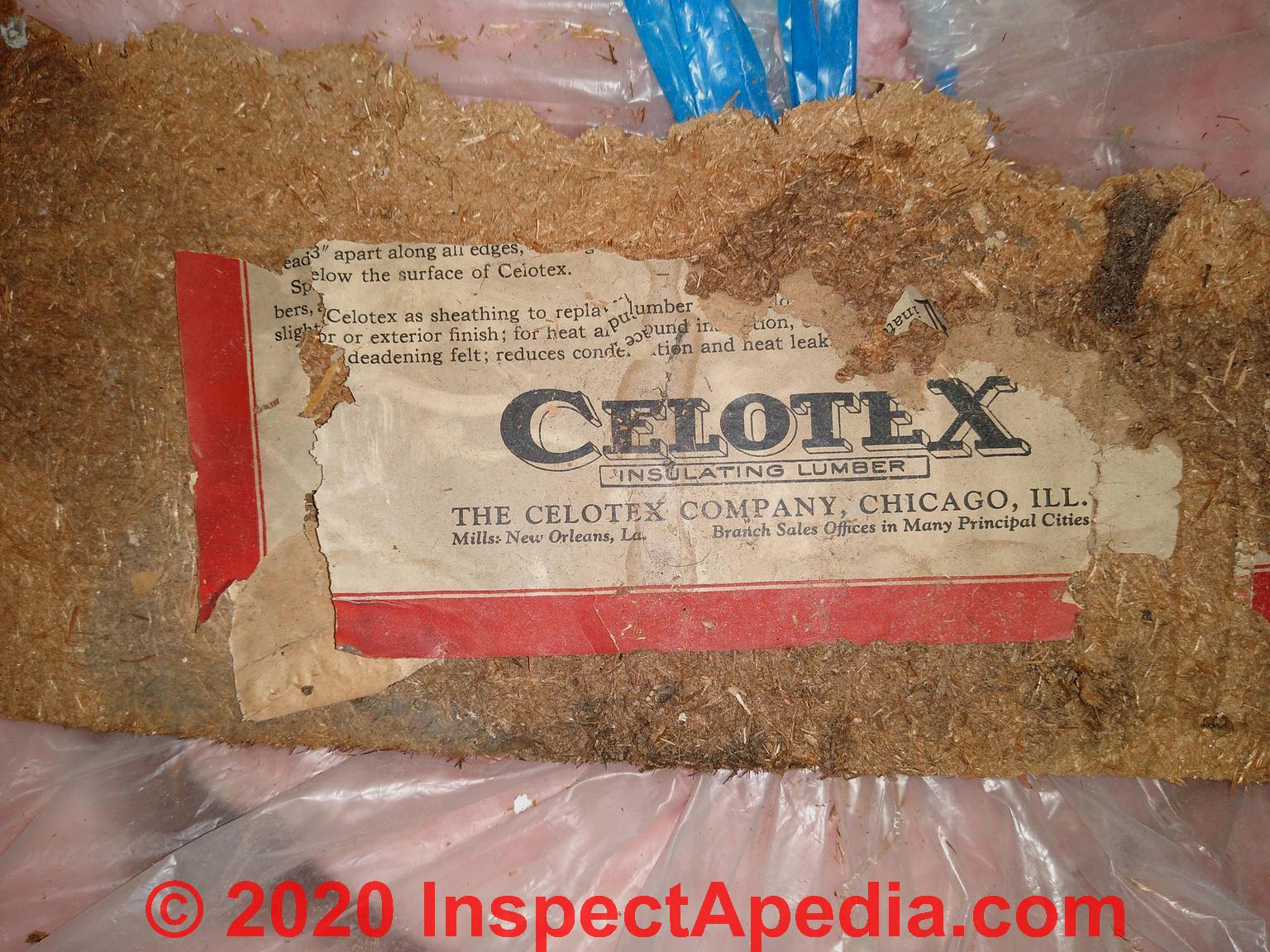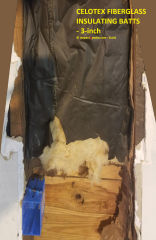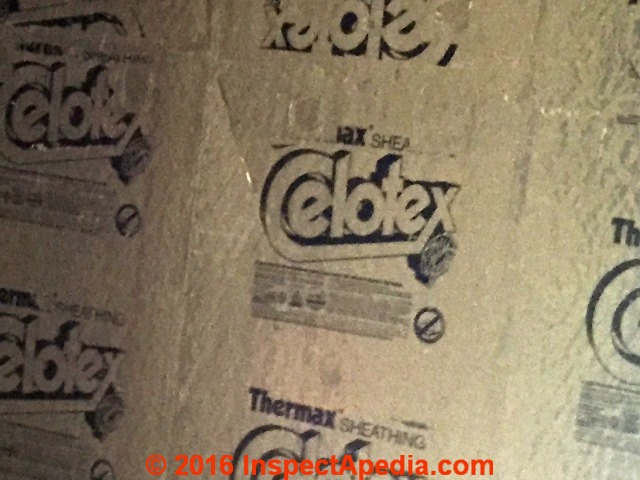 Celotex® Products & History
Celotex® Products & History
Complete history of Celotex, insulating & wall board properties, asbestos
- POST a QUESTION or COMMENT about Celotex products and history.
Celotex insulating board & wall covering products & corporate history:
A review of the dates involved in the product history of Celotex Corporation can help identify which Celotex insulating board or wallboard or drylining product you may have found in a building.
This article series gives the history and properties of Celotex® Thermax and other foam board insulating products.
Page top photo: Celotex® Thermax sheathing board insulation.
InspectAPedia tolerates no conflicts of interest. We have no relationship with advertisers, products, or services discussed at this website.
- Daniel Friedman, Publisher/Editor/Author - See WHO ARE WE?
Celotex™ Sheathing & Insulating Boards: Company History, Products, Dates
Our photograph is of brown, white-imprinted Celotex cellulose-based insulating board, possibly bagasse, used as an insulating sheathing board on both the exterior and interiors of buildings.
[Click to enlarge any image]
Celotex Corporation produced the first fiberboard made from bagasse in 1920. (Jester 2014). Other records indicate that the company was founded a year later, in 1921.
Celotex Insulating Lumber, the company's first product, was a cellulose fiber board made from bagasse or sugar cane fiber using a felting process, and produced in Celotex's New Orleans LA plant.
Celotex described their Celotex Insulating Lumber as an exterior sheathing product intended for use as a base beneath plaster or beneath a stucco building exterior as well as for roof insulation.
Celotex insulating lumber was sold in 7/16" thicknesses (and possibly other thicknesses), in 4 foot width boards at lengths from 8 ft. to 12 ft. and weighing about 60 pounds per square (100 sq.ft.).
Celotex continues to operate in the present, producing various building sheathing and insulating products, having passed through various reorganizations and changes listed below in this article.
Celotex Installation Instructions for Sheathing
Special thank-you to reader Lisa who contributed this hard-to-find label providing basic installation instructions for Celotex sheathing board and for use of Celotex as a plaster lath alternative.
As the original Celotex instructions label, quoted verbatim below, included "Remove this label before applying plaster.", one can understand why finding this label intact was a pleasant surprise.
[Click to enlarge any image]
Doing a renovation on my old house. I found this pristine label and attempted to date the material. I have no definitive answers but thought I’d upload a picture anyway. - Lisa 2019/02/21
The following is a transcription of the original Celotex installation instruction label's text.
How to apply Celotex
Sprinkle lightly and pile Celotex boards not less than one day before nailing, using a hose, sprinkling can, or broom dipped into a pail of water, while the boards are being unloaded and piled. Sprinkle indoors in cold weather to prevent freezing.
Nail boards to framing within two hours after removing from the pile.
Space studs, joists and rafters accurately on 16” centers. Cut in 2” x 4” headers at all horizontal board joints and every 4’ on ceilings. Apply Celotex lengthwise to studs, joists, and rafters, nailing directly to framing.
Leave 3/16” space between boards and at top and bottom of Celotex boards. Do not butt boards together or force into place.
Nail first to intermediate frame members, then entirely around all edges of each board, placing nails 3/8” away from edge.
Use standard 1 1/2” galvanized roofing nails with 3/8” heads.
Space nails 6” apart along intermediate frame members and 3” apart along all edges, driving until heads are slightly below the surface of Celotex.
…
Use Celotex as sheathing to replace lumber and building paper; under plaster, replacing lath; as an interior or exterior finish; for heat and sound insulation, etc. Celotex insulates and quiets sound, eliminates deadening felt, reduces condensation and heat leakage. Insures winter and summer comfort.
Celotex Insulating Lumber, The Celotex Company, Chicago, ILL. Mills: New Orleans, LA. Branch Sales Offices in Many Principal Cities.
Reader comment: Celotex Standard Building Board found in 1929 home
2019/12/14 Denise said:
My house was built in 1929
We just took down the ceiling the fiber board was cracked and after some attempted to repair found this between the floor and ceiling.
Hope you are able to open the the photo
Sincerely Denise
[Click to enlarge any image]
Reply:
Thank you for the excellent photo of Celotex Insulating Board, Denise. It's helpful to have this document describing Celotex "cane board" that was used as a plaster base. Was it indeed plastered over in your home?
I'll add your photo to the article above. It would also be helpful to know the country and city where your home is located.
Celotex Installation Instructions as a Plaster Base - Lath Substitute
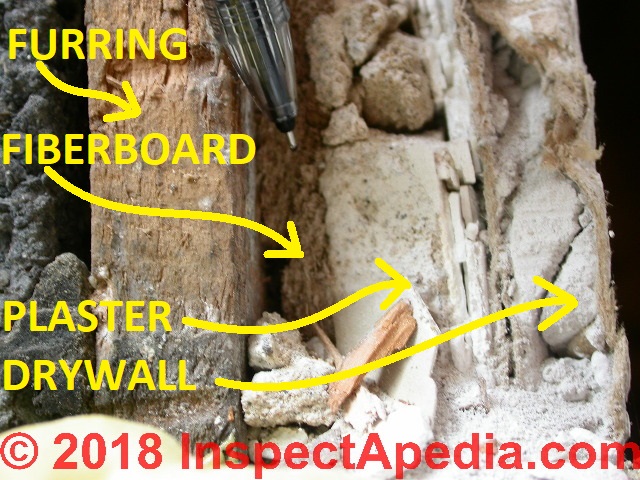 [Celotex] Plastering Directions
[Celotex] Plastering Directions
Apply Celotex, in place of lath, to framing as directed above, giving special attention to sprinkling, and nailing. Cut open board joints, spaced less than 3/16” wide.
Reinforce plaster at all inside corners, and where frame and masonry walls meet, with metal lath and reinforce the exterior corners with corner beads.
Strips of metal lath, 4” wide, over board joints will reinforce the plaster, particularly in ceilings.
Do not moisten Celotex after nailing.
Use a quick-setting Gypsum plaster; if plaster used fails to “set” within two hours, add an accelerator.
Do not use lime plaster or mix lime with Gypsum plaster in scratch or brown coat.
First coat, or scratch coat and brown coat together, must never be less than 3/8” thick, and must be thoroughly dry before applying finish coat. Finish coat thickness must not be over 1/8”.
Apply plaster directly to Celotex; force into plaster well into board joints. Darby strokes must be in the direction of joists and studs, being careful to always span two joists or studs with rod or darby.
Thoroughly ventilate with fresh air from open windows, especially in cold weather. Remove this label before applying plaster.
Dates & Events in the History of Celotex
In the U.S., Celotex was a Delaware corporation founded in 1921. The company manufactured and distributed roofing and building products for residential and commercial use. The company continues in business principally under Jim Walter (since reincorporating in 1964) and Saint-Gobain and as Celotex in the U.K. In the U.K., the company's principal product is polyisocyanurate insulating foam board.
In Canada, Carey-Canada Inc., a Celotex subsidiary, was responsible for mining and processing asbestos fiber and loose-fill shorts used in a range of Celotex building materials until the Carey mine was closed in 1986.
Celotex filed for bankruptcy on 12 October 1990 and completed a financial reorganization on 9 December 1996. It participates in an asbestos trust.
The U.S. headquarters of Celotex is Tampa, Florida.
Calendar Events in the History of the Celotex Corporation
- 1921: Celotex Corporation founded in the U.S. with Celotex Company of Great Britain established in the same decade. Importer of bagasse fiberboard used to make a variety of wood-cellulose-based insulating sheathing products.
- 1925: The Celotex Company of Great Britain started trading in 1925 from offices located in Australia House in The Strand, London.
The business was a subsidiary of its parent company, the Celotex Corporation of America, and soon established itself as an importer of bagasse fiberboard insulation from the original Celotex manufacturing plant in Marrero in the state of Louisiana, USA. - 1933: Carey Canada, a wholly owned subsidiary of Celotex, was engaged in the mining, milling and processing of asbestos fiber from 1933 or earlier. We found citations describing Carey (president George Crabbs) and others named in hearings and litigation as early as 1933 and continuing in 1944. (Castleman 2005)
Philip Carey also operated an asbestos-insulation products manufacturing plant at Plymouth Meeting, Pennsylvania until the closure of that facility in 1962.
The Carey mine is part of asbestos deposits following the Pennington sheet on a NE strike roughly parallel to route 112.
The Carey mine, located between 3e Rang and the 4e Rang, is the largest open pit in the region, almost 1km long by 0.5km. These deposits were discovered in 1907 and they were worked on and off until 1986. Coordinates: 46.254 -71.04 - https://www.mindat.org/loc-205395.html 2017/11/08
See details at CELOTEX ASBESTOS TRUST FUND
and at Philip Carey ASBESTOS PRODUCTS - 1930: Celotex opened a U.K. manufacturing plant at Stonebridge Park in the 1930's. The Celotex insulating board and hardboard product lines were introduced in the 1950's.
- 1938: Celotex assumes control of Certain Teed building products.
- 1943: Celotex wood fiber board and gypsum board products saw increasing use in construction due to the scarcity of building materials during WWII. Above: advertisement for various Celotex sheathing board products as appearing in Architectural Record, October 1943, p. 16.
- 1944: in proxy fight, R.W. Liazars takes control of CertainTeed from Celotex.
- 1950s: Celotex introduced new insulating board products and later, hardboard products.
- 1964: Celotex purchased by Jim Walter & reincorporated as Celotex Corporation of America.
- 1966: Celotex Stonebridge West London, UK plant closed. This plant was a producer of bagasse-based insulating board.
- 1967: Philip Carey Manufacturing Company was restructured and became a subsidiary of the Rapid American Corporation.
[Disclosure: the InspectApedia.com website publisher's father's clothing company in Richmond, VA, Friedman Marks Clothing Co., though they had nothing to do with asbestos mining, was also purchased by the Rapid American Corporation around this time.] - 1968: In the U.K., the Stonebridge Park Celotex manufacturing facility was closed and a warehousing / distributing site was opened at Hadleigh (1968).
- 1970: The Celotex Corporation of America introduced an isocyanurate foam ceiling tile [11] (not an asbestos-containing product). By this year, asbestos was widely used as fireproofing in roofs, floors, ceilings.[28]
In the U.S., the Celotex Corporation of America introduced isocyanurate foam insulating tiles in the 1970's.
In the U.K., Celotex began producing rigid poyisocyanurate foam insulating board (PIR foam board) at a manufacturing facility at Hadleigh, Suffolk.
- 1980: In the U.S., in the 1980's, Celotex Thermax insulating board was described by the Celotex Company (Jim Walters corporation, Tampa) as an insulating sheathing board with an R-value of 5.4 for a 3/4" thick board: higher R than its competitors at the time as it was compared with foam insulating board sold by Dow, WR Grade and Simplex.
- 1986: Celotex-owned Carey Canada Inc., asbestos mine closed. The mine's production had fallen from 240,000 tons at capacity to under 100,000 tons of annual output and the number of employees had already fallen from about 550 down to 189.
Mike Prus, president of Carey Canada, succinctly explained the problem. ''There is an overproduction of asbestos,'' he said. ''The prices are very low. Our costs are too high. We cannot compete.'' - (Martin 1986) - 1989: U.S. jury award to Marion George in lawsuit concerning her husband who worked as an asbestos insulation contractor/distributor..
- 1990: Celotex and Carey Canada bankruptcy filing, under Chapter 11 of the U.S. Bankruptcy code - 12 October 1990.
On October 12, 1990, U.S. Celotex Corporation and Carey Canada Incorporated filed for reorganization under Chapter 11 of the U.S. Bankruptcy Code. The company's reorganization was completed more than six years later on 9 December 1996.
The Trust was created as a result of the bankruptcy. The Trust is organized to process, liquidate and pay all valid asbestos personal injury claims in accordance with the Claims Resolution Procedures (CRP) approved by the bankruptcy court.
- 1996: Celotex Corporation reorganized, 9 December 1996.
- 1997: Celotex Corporation reorganized.
- 1998: Celotex asbestos injury trust fund created ($1.246 million). Claims against Celotex and its asbestos mining subsidiary Carey Canada for asbestos exposure and mesothelioma claims.
Details are at CELOTEX ASBESTOS TRUST - 1999: US EPA ASBESTOS MATERIALS BAN: CLARIFICATION PDF]
This document makes clear that EPA has no existing bans on asbestos-containing products other than items listed in this document: ACM ceiling tiles were not banned.
Note: however because of public resistance to purchase or use of ACM products, many manufacturers discontinued of asbestos in various products, particularly after 1976. Check the individual product MSDS for confirmation of its content. - Ed. In this year, Great Britain banned the sale or re-use of white asbestos. [26] - 2000: BPB PLC, a U.K. firm, purchased Celotex's ceiling product line and Celotex's gypsum wallboard operations.
- 2000: CertainTeed purchased Celotex Roofing, ultimately Saint-Gobain Corporation (U.S.)
In the U.S. ,Celotex® foam board insulation was later purchased by Dow Chemical who continues to market polyisocyanurate foam insulating board. - 2001: Dow Chemical Corporation acquired Celotex's rigid foam insulation business In July 2001.
See CELOTEX THERMAX ASBESTOS? for details.
- 2002: In the U.K., Celotex and Sundeala had merged and de-merged by 2002, resulting in move of the U.K. Celotex headquarters to Hadleigh, Suffolk.
- 2003: In 2003, the Celotex Asbestos Settlement Trust paid New York City for property damages of schools and buildings based on over 400 claims.
- 2008: Celotex production of laminated plasterboard PL4000 was begun as a product used for dry-lining installations. In 2008, Celotex introduced a Class O fire rated board product FR4000, a PIR product available only from Celotex.
- 2012: Celotex Corporation continues operations in the U.K. selling foam board (polyisocyanurate foam) insulation.
In September 2012 ,Saint-Gobain, the world leader in the habitat and construction markets, acquired Celotex. Celotex continues to market polyisocyanurate insulating foam board (PIR) in the U.K.
The company's current products include rigid polyisocyanurate (PIR) foam boards bonded to plasterboard, for use as insulating dry lining for internal wall applications in existing domestic and non-domestic buildings.
Examples of Early Celotex fiberboard products:
- Celotex or Knight Celotex [11] - see IDENTIFY Celotex® Insulating Board and Fiberboard Products
- Celotex Blue Ridge™ Fiberboard
- Celotex SturdyBrace®
- Celotex Tile Board, 16" x 32" ceiling panels - do not contain asbestos (See Celotex Asbestos Products link below)
- Celotex Vitricel asbestos sheets
- See also CANEBOARD PANELS
- See also FIBERBOARD SHEATHING
- Separately at CELOTEX ASBESTOS PRODUCTS we provide a complete list Celotex products that contained asbestos
Research History of Celotex Corporation & Its Products
- Bruce, Daniel C., "Composition of matter." U.S. Patent 1,804,245, issued May 5, 1931.
The putty described by this invention was comprised of water, flour, borax and glycerine as well as a hydrocarbon such as gasoline or kerosene or benzene to form a preservative soap emulsion.
Abstract:
This invention relates to a composition of matter and it is an object of the invention to provide a composition of a soft putty consistency and which is particularly intended to be used as a filler in connection with the application of commercial wall board manufactured from fibres obtained from cane, asbestos, wood, flax, straw, or other absorbitant fibres such as, and including, the wall 1 board now used and manufactured and known as Celotex, Beaver board, Sheetrock, Best-wall, Masonite, Insolite, Gypsolite, Rockboard, Cornell, or Upson wall board, and other boards made from cane, asbestos, wood, flax, straw, or gypsum.
Another object of the invention is to provide a composition of this kind which is particularly intended for use in the filling of joints, covering nail heads and coating the surface of wall board, etc. An additional object of the invention is to provide a composition of this kind which is adapted to produce an invisible joint; to take the place of plaster, coating, or paint; and upon the omission of fibrous matter to produce a liquid composition for sizing walls before the application of paint or wall paper. ...
There is then added one pound of comminuted fibres taken from cane fibre or Celotex wall board fibres obtained from asbestos, wood, straw, or other absorbitant fibres. These fibres are thoroughly mixed with the admixture and kneaded until it forms a putty-like product.
In order to match the Celotex Wall board in color when cane fibres are used, suitable coloring matter soluble in water may be added to the first named admixture to obtain desired tints although ordinarily the composition when dry, owing to the action of the whiting or powdered chalk, causes the fibres to dry light in color and thus prevent water stain[s]. - Castleman, Barry I. Asbestos: medical and legal aspects. Aspen Publishers, 2005.
- [2] Celotex Corporation [Website] PO Box 31602, Tampa FL 33631, with offices in Atlanta, Chicago, Cincinnati, Dallas, Oakland and Philadelphia, and plants in six U.S. States is headquartered in Tampa, FL. Celotex is a national manufacturer of residential and commercial building materials. Website: www.celotex.com Tel: 800-CELOTEX Website: http://www.celotex.com
INSULATION SELECTOR GUIDE [PDF] Celotex Corporation, web search 6/29/12, original source: http://www.silvercote.com/PDF/ThermaxInsulSelectorGuide.pdf, [copy on file as CelotexThermaxInsulSelectorGuide.pdf ]
CELOTEX BLUE RIDGE FIBERBOARD", STURDYBRACE® [PDF] produced by Blue Ridge Fiberboard Inc., 250 Celotex Dr., Danville VA 24541, product literature, web search 6/29/2012, original source: blueridgefiberboard.com/pages/sturdybrace.php, [Copy on file as Celotex_BlueRidge_SturdyBrace.pdf].
CELOTEX BLUE RIDGE FIBERBOARD MSDS [PDF] original source: blueridgefiberboard.com/pages/sturdybrace/pdfs/SturdyBrace-msds-br.pdf
"Guide Specifications: SturdyBrace® Structural Fiberboard Wall Sheathing", 6/29/12, original source: blueridgefiberboard.com/pages/sturdybrace.php [Copy on file as SturdyBrace-guidespecs.pdf] - CELOTEX TRUST[websigte] retrieved 2017/11/08 original source: the Celotex Trust, Website: http://www.celotextrust.com/ Tel: 800.708.8925
- CELOTEX UK, HISTORY of Celotex, Celotex [PDF] Lady Lane Industrial Estate, Hadleigh, Ipswich, Suffolk, IP7 6BA U.K., Email: info@celotex.co.uk, Tel: 01473 822093 Technical enquiries (lines open 8am - 5.15pm): 01473 820850 Retrieved 2017/11/08 original source: https://www.celotex.co.uk/about/history
- Celotex, "Cemesto, Five Tested Ways to Meet Today's Building Needs with Minimum Use of Critical Materials", The Celotex Corporation, Chicago, Architectural Record, October 1943 p. 16 [Advertisement] The ad describes several Celotex wallboard and sheathing products including:
- Celotex Asbestos Board builds walls fast. This new Celotex product is a hard, durable combin ation of portland cement and asbestos fibre, 3/16" or 1/4" thick, available in boards 4' x 8', for fast erection of interior walls and ceilings. Can also be used for exterior finish on temporary or permanent structures.
- Celotex gypsum interior wall units save studding, save time. These extra-thick gypsum wall board are either 1" or 1 1/2" thick, and building strong, sturdy, good-looking interior parttions in the shortest possible time, with only a simple wood framework. Known as "single wall construction" this method saves much critical lumber.
- Celotex insulating board sheathing comprised of 1/8" Cement-asbestosboard for exterior and interior finish, a water and vapor proof bituminous adhesive, Celotex Ferox-treated Cane-Fibre Insulation.
- Cemesto, Cemesto combines strength, insulation, interior and exterior finish, sold in panels from 4' x 4' to 4' x 12'. "Cemesto is a revolutionary building material that comes in panels from 4' x 4' to 4' x 12' to provide a complete fire-retardant wall or roof unit. Thickness ranges from 1 1/8", 1 9/16" to 2". Today, Cemesto with 12 years of research behind it is speeding construction ofmillions of dollars' worth of wartime homes, housing projects, factories, shops and hangars using a minimum of critical material. Can be sued with either wood or steel framing. Saves time, labor, lulmber and nails.
- Celo-Siding combines siding, sheathing, insulation. This new multiple function insulating siding consists of cane fibre insulation, coated on both sides with moisture-proof asphalt, with a weather surface of crushed mineral granules in colors to provide a permanent exterior finish. It is applied direct to studding. Two thicknesses 7/8" and 5/8".
- Celotex Gypsum Roof Slabs replace wood roof decks. These new laminated gypsum roo9f deck slabs are offered in 1", 1 1/2" or 2" thicknesses, 2' wide, 8, 9', or 10' long, rigid, strong, light in weight and easy to handle. The big units cover roof areas quickly, saving important time. Roof covering can be applied immediately.
- CELOTEX INSULATION CELOTEX PIR PLASTERBOARD THERMAL LAMINATES Agreement Certificate [PDF] retrieved 2017/11/08, original source: https://www.celotex.co.uk/assets/plasterboard-laminates_bba-certificate_sep2016.pdf
Abstract:
This Agrément Certificate Product Sheet(1) relates to Celotex PIR Plasterboard Thermal Laminates, comprising rigid polyisocyanurate (PIR) foam boards bonded to plasterboard, for use as insulating dry lining for internal wall applications in existing domestic and non-domestic buildings. - Hipchen, Donald E., Michael J. Skowronski, and Joseph R. Hagan. "Structural laminate and method for making same." U.S. Patent 4,118,533, issued October 3, 1978.
- Mauney, Matt, "Celotex Corporation" [Web article], retrieved 2017/11/08, original source: https://www.asbestos.com/companies/celotex.php
- Martin, Douglas, "Asbestos Decline in Canada", The New York Times, 6 February 1986, retrieved 2017/11/08, original source: http://www.nytimes.com/1986/02/06/business/asbestos-decline-in-canada.html?pagewanted=all
- Ohashi, Takashi, Toru Okuyama, Akira Suzuki, and Katsuhiko Arai. "Asbestos-metal surfaced urethane modified polyisocyanurate foam." U.S. Patent 4,292,361, issued September 29, 1981.
- 760 F. 2d 481 - Van Buskirk v. Carey Canadian Mines Ltd J Neal R J 82-1608 Asbestos - Open Jurist [Website] retrieved 2017/11/08, https://openjurist.org/760/f2d/481/van-buskirk-v-carey-canadian-mines-ltd-j-neal-r-j-82-1608-asbestos-corporation-limited-82-1622
- [10]
Patents pertaining to building insulation & insulating board, Celotex & Insulating Board type products
- "Sound absorbing board for walls and ceilings", Patent No. 1,554,180, issued to W.S. Trader, September 15,1925, first disclosed a wallboard constructed from "Celotex", a felted mass of strong bagasse fibers, so compacted as to be capable of use as an artificial lumber in that it can be sawed and nailed, and has sufficient strength in many cases to be substituted for lumber. That same patent mentions "Insulite", a building board made from wood pulp tailings and which likewise has a porous fibrous body portion and which is possessed of considerable strength so that the same can be nailed, etc. Celotex was preferred as an insulating material because its internal cells produce a sound-deadening insulating effect.
- "Method and apparatus for drying moving material", Treadway B. Munroe et als, assigned to Dahlberg & Co., U.S. Patent No. 1,598,980, 7 September 1926, described a method and apparatus for drying sheets of artificial heat insulating lumber, known on the market as Celotex, improving the original process.
- "Reinforced composition board", Treadway B. Munroe et als, U.S. Patent No. 1,578,344, 30 March 1926
- "Insulating Structural Board", U.S. Patent 2,159,300, Armen H. Tashjian et als, assigned to William B. Miller, Lakewood OH, 23 May 1939, describes insulating structural boards of laminated construction for use as roof or floor slabs, and refers to "Standard insulating fiber boards, such as "Celotex", "Masonite", "Insulite", etc. that had excellent insulating properties but have relatively slight structural strength in flexure or bending under load, hence are not and cannot be used as structural slabs for load sustaining purposes, as roof or floor slabs, for example. [Adding structural strength ran into the problem of reducing the insulating value of the product.]
- "Sound-absorbing chamber", Treadway B. Munroe et als, U.S. Patent No. 1,705,778, 19 March 1929 (using Celotex to construct a sound deadening chamber.
- "Method of and apparatus for drying moving material", U.S. Patent 2,376,612, Carl G. Muench, New Orleans, assigned to Celotex Corporation, described a method and apparatus for drying sheets of artificial heat insulating lumber, preferably formed by the felting of bagasse fiber along with other materials necessary to make a satisfactory structural fiber board. 22 May 1945
- "Sound-absorbing board for walls and ceilings," U.S. Patent 1,554,180, Sept. 15, 1925, Wilber S. Trader, assignor to Dahlberg & Company, Chicago IL. described an interior-use sound insulating product.
- Popular Mechanics, October 1984, advertisement p. 139 for Celotex wallboard
- Sandberg, Lynn, "Celotex in Upper Michigan", Forestry Division, The Michigan Tech Forester, Forestry Club, Michigan College of Mining and Technology, Houghton MI, Vol XII (1961) pp. 16-17. [No mention of asbestos in this article.]
Excerpt:
For commercial installation, Celotex markets the well known line of Acousti -Celotex acoustical ceiling tile and suspension systems including economical fiberboard tiles, incombustible mineral fiber panels [possibly containing asbestos - ed] and efficient steelbase sound-absorbing tiles. The firm manufactures asphalt shingles, roll roofing and asphalt roofing felts.
Celotex is also a major manufacturer and supplier of Celo-Rok gypsum wall board, sheathing and plaster; mineral wood insulating blankets and Handi-Pak home insulation; insulating siding; decorative interior hardboard panels and exterior hardboard siding; and indus rial fiberboard for a wide range of other applications such as packaging of delicate or irregularly shaped items and as a component of other products. - Tuscaloosa News, 14 June 1944, p. 7, classified ads, Excerpt: " For Sale - Make your own fan, limited lot ... Celotex celling tile board, Celotex insulation board, Celo-rock wall board for walls and celling, plaster, plaster lath. Kern-tone Miracle paint, ... All kinds of building materials. J. Oviatt Bowers Co., Phone 4456 14-3tp"
...
Reader Comments, Questions & Answers About The Article Above
Below you will find questions and answers previously posted on this page at its page bottom reader comment box.
Reader Q&A - also see RECOMMENDED ARTICLES & FAQs
On 2024-05-10 by Andrew Morgan - Did Celotex produce or manufacture asbestos-containing products at their factory in Stonebridge West London UK ?
Did Celotex produce or manufacture asbestos-containing products at their factory in Stonebridge West London UK in the period 1955 to 1968 (when production of any products came to an end)
On 2024-05-15 by InspectApedia Publisher (mod)
@Andrew Morgan,
The Celotex plant at Stonebridge in West London, UK, was opened in the 1930s and remained in operation until its closure in 1966. The principal product was fiberboard sheathing - a plant based product made of bagasse.
In the 1950s a "new insulating board" product is mentioned in the company's documentation (cited below) and later a new hardboard product (also generally wood fiber based) without, unfortunately, any description of its constituents.
The word "asbestos" never appears in the HISTORY of CELOTEX in the UK [PDF] found at
https://inspectapedia.com/interiors/Celotex_History_UK.pdf
Other companies operating in the UK had a long history of production of asbestos-containing products including insulating boards:
Asbestolux (produced by Cape Asbestos, originating in South Africa), from 1913 in the UK in Barking, Essex - see https://pubmed.ncbi.nlm.nih.gov/12541265/ ) and also Turnabestos (produced by Turner & Newall, Rochdale England, 1871 - 1970s - see https://en.wikipedia.org/wiki/Turner_%26_Newall ) were product names for asbestos-containing insulating boards (AIB or "Asbestos Insulating Boards) produced in the UK from the 1950s to about 1980.
Those were different companies, not part of Celotex. .
On 2023-07-06 by STEVE - Does CELOTEX Celo-Glass IV Ply roofing "felt" material contain asbestos?
Does the CELOTEX Celo-Glass IV Ply roofing "felt" material contain asbestos? Thanks, steve
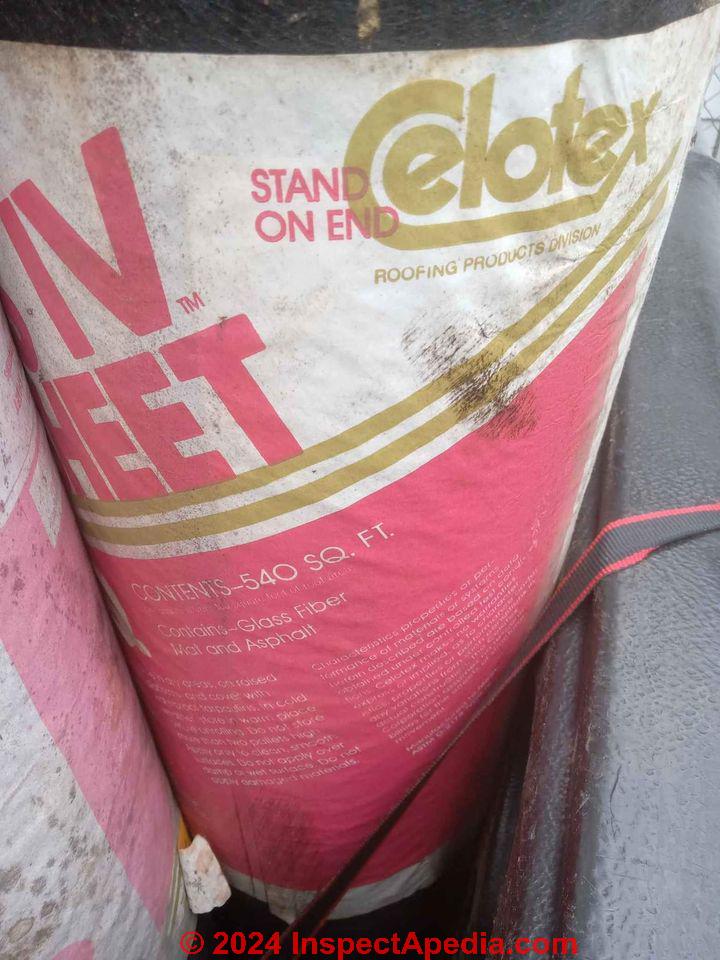
On 2023-07-06 1 by InspectApedia Publisher (mod) - not likely
@STEVE,
Asbestos in Celotex Celo-Glass IV Py roofing felt?
Thanks that's a subtle question. On the face of it, Celotex Celo-Glass IV Ply roofing underlayment or "felt" was made simply of a fiberglass mat impregnated with asphalt - just as the product label shows - below I include a zoom in from your photo.
Bottom line, though, is we don't know for sure. Some traditional asphalt-impregnated paper (roofing felt) often contained fiberglass as a strengthening fiber added to the product. I don't know for a fact but I'm doubtful that Celotex would have needed to add asbestos fibers to "strengthen" a fiberglass mat.
So probably not.
I searched for a Celotex Celo-Glass underlayment SDS or MSDS without success.
It's interesting that the more-generic named form, Type IV Glass Ply Felt is still sold, such as by Carlisle that is described in the PDF link I'll provide below.
Naturally none of the current roofing products are going to assert the use of asbestos in their formula.
CARLISLE TYPE IV GLASS PLY FELT PDS [PDF]
https://inspectapedia.com/insulation/Carlisle-Type-IV-Glass-Ply-Felt-Product-Data-Sheet-PDS.pdf
Here's another example,
Durapax ASPHALT ORGANIC BASE SHEET MSDS [PDF]
https://inspectapedia.com/insulation/Durapax-Asphalt-Organic-Base-Sheet-MSDS.pdf
Tell me where your rolls of Celotex Celo-Glass are located (country, city) and your guess at their age. I suspect that product has been in storage for over twenty years - and is likely to be found not in fit shape to use.
I'd also be grateful for more, sharp photos showing us all of the text on the product packaging.
On 2021-02-10 by Gerard B
I own a custom built house from 1925 with celotex lath throughout . Also some of the ceilings are coated with cursed calcimine . The plaster is in good shape for 95 years old . The walls are REALLY hard
On 2021-02-10 by danjoefriedman (mod)
Thank you for that description of 1920's Celotex plaster-board lath, Gerard. A photo would be also helpful, especially if there is a place where an edge or cross-section of the wall or ceiling material is visible.
Comment: 1927 Celotex Advertisement in Better Home & Gardens
I thought you might be interested in this advertisement from July, 1927 edition of Better Homes and Gardens. - Joyce Rublack
[Click to enlarge any image]
Moderator reply:
Thank you Joyce.
Question: does this Celotex insulation contain asbestos?
Was wondering if anyone knew weather this attic insulation contains asbestos, thanks in advance! Luke
This Q & A were posted originally
at CELOTEX ASBESTOS PRODUCTS FAQs
Moderator reply: no; mineral wool is not asbestos.
Luke
Your nice photo identifies Celotex mineral wool - which is not an asbestos material.
Details about this type of insulation are found
at MINERAL WOOL - ROCK WOOL INSULATION
You may also want to review the question of cross contamination
Does this old Celotex fiberboard contain asbestos?
Tim said:
Hello I tried to send this question the other day not sure whether you got it not sure how to get an answer but
I do have the cello tax board underneath the live edge siding on my house that I’m renovating and
I just wanna know what the probability is that there would be asbestos in this
I believe this is the material that strictly made out of the sugarcane
Fibbers but perhaps you have an opinion on that I’d really appreciate the help thank you - by Tim -
On 2020-09-25 by (mod) - Celotex fiberboard exterior insulating sheathing, probably Caneboard
Tim, please see your photo and question now posted at
Determine the flame spread and smoke index for 1950's Cane Celotex 12"x12" ceiling tile
Am involved with a mechanical renovation to what was a 1950's era school that is now office space. The building is single story with celotex on the the underside of a conc. roof deck.
When the building was provided with air conditioning, a second suspended ceiling system was installed
I am trying to determine the flame spread and smoke index for 1950's Cane Celotex 12"x12" ceiling tile (that is now in a concealed space). Found 1938 sweets catalog for Celotex from APT library, but the brochure did not list smoke index rating.
Any suggest on where to locate the data is appreciated. - On 2020-09-18 by Garry -
On 2020-09-19 - by (mod) - history of flame spread & smoke index ratings for building materials in the U.S.
Garry
The question of flame spread and smoke index is an important one, but if the contemporary standards such as ASTM-E84 or NFPA 286 were not extant when Celotex manufactured that ceiling material then we may not find those fire rating and smoke rating data for it unless you happen to find some researcher who did testing somewhat later-on.
See also
- Lawson, James. "A history of fire testing: Past, present, and future." In Advances in the State of the Art of Fire Testing. ASTM International, 2010. Available from NIST or
Download here at
HISTORY of FIRE TESTING, LAWSON [PDF]
Excerpt:
Surface flammability of interior finishes, including flooring, apparently was addressed in 1926, as reported by the NFPA Quarterly.33 The danger from interior finishes was emphasized again during the 1940s by fires such as the Coconut Grove night club fire (1942), the Winecoff, La Salle, and Canfield Hotels fires of 1946, and the St. Anthony Hospital fire of 1949.34 Each of these fires had heavy loss of life and extensive property damage resulting in large financial losses.
As a result of theses fires S. H. Ingberg (NBS) and A. J. Steiner (of Underwriter’s Laboratories) took on the challenge to develop a fire test method for measuring the fire performance of finishes and flooring materials.
This work saw the development of a large flame-spread tunnel furnace which eventually became an Underwriters’ Laboratory test method in 1944 and also became ASTM E84 (in 1950), and was adopted by NFPA as Standard No. 255.34 (Figure 3)- Shoub, Harry. "Early history of fire endurance testing in the United States." In Symposium on Fire Test Methods. ASTM International, 1961.
On 2020-05-26 8 by Anonymous - what do I do with old Celotex fiberboard?
I have found a mountain of this stuff around a jacuzzi dismantle. What do i do with it?
I have been handling it with cartridge respirator and full clthing. but Im scared.\
On 2020-01-24 by (mod) - old fiberboard = construction waste
It is always smart to wear personal protective equipment and to protect yourself from breathing dust from demolition debris of building materials. But as long as your "stuff" was wood based fiberboard, there's not the additional hazard of asbestos exposure.
Depending on where you live, typical regulations will have you dispose of your dismantled fiberboard sheathing as construction debris. That might mean it can be bagged as trash or you might be asked to transport it to a waste facility accepting construction debris materials.
On 2020-01-24 by (mod) - Celotex label from a 1928 home
Karen
Thank you for this contribution to the history of Celotex "Insulating Lumber" - in this case fiberboard sheathing. I'll be sure to keep it with the article.
On 2020-01-24 by Karen
Renovating my 1928 home. Found this stuff on all the Wald.
On 2018-02-26 by pamela foster - Father worked at Stonebridge UK, died from lung cancer
My father worked at Celotex in Stonebridge for over twenty years, he did not smoke, but died from lung cancer, could working with asbestos have caused this?
On 2018-02-26 by (mod)
Pamela,
I speculate that is possible, but you would certainly need more information. Besides possible hazards from this dust those breathing high levels of Airborne dust of many particle types could be potentially irritating. You might start by asking your dad's doctor for an opinion.Stonebridge UK produced principally bagasse-based fiberboard sheathing, later hardboard and other insulating boards whose composition isn't stated in our history of the Stonebridge, UK Celotex plant.
Question: Does this Celotex insulation contain asbestos?
I am remodeling an older home prob built in 60s opened wall to outside and found Celotex insulation .
Any way I can find out if it has asbestos in it?
This Q&A about Celotex insulation was posted originally at
CELOTEX ASBESTOS PRODUCTS FAQs
[Click to enlarge any image]
Reply: this Celotex™ is fiberglass - no asbestos
Thanks for the photo and question, Scott.
Enlarging to see the photo clearly,
your image shows Celotex™ fiberglass insulation in 3-inch batts faced with what looks like black kraft paper.
Fiberglass isn't an asbestos-containing product unless somehow it got cross-contaminated from another source.
Question: Asbestos in Philip Carey Insulation?
 We recently had some windows replaced and some wall was torn out in an early 1960's home. We noticed that there was some Philip Carey bagged insulation in there.
We recently had some windows replaced and some wall was torn out in an early 1960's home. We noticed that there was some Philip Carey bagged insulation in there.
After review of a Carey catalog page from that era we are confident in assuming that it's just glass insulation. Though, under the older exterior wood of the home, there was underlaying of some type of tar paper which appeared black.
Given that some products of the home were sourced from P. Carey would that black paper pose any type of risk from that time period and from any supplier? - Anonymous by private email 2019/09/07
Reply: Not likely unless cross-contaminated; other PC products did contain asbestos. Details of Philip Carey Insulation including Rock Wool
https://inspectapedia.com/Design/Carey-Rock-Wool-1950.pdf is an example of Philip Carey rock wool insulation - that may be what you have.
I'd like to see photos of your insulation, of any labeling you found, and of the black felt or "tar paper" about which you're asking; then I can comment further.
We also discuss Philip Carey's operations at https://inspectapedia.com/insulation/Celotex-History-Products.php
Watch out: even when insulation such as mineral wool does not contain harmful particles such as asbestos, some felt paper used on some insulation products may itself have contained asbestos. It's not a friable material - the hazard, especially left undisturbed, is likely to be minimal.
Reader follow-up:
Thanks for the reply; unfortunately due to circumstances(today) that were out of my control pictures are no longer a possibility; Don't think the black stuff was that rock wool because those are pictured as blankets.
As for the insulation - I assume it's the Carey Thermoglas type like in the brochure that someone put on Flickr . com
They were packed(interestingly enough look like long blankets in that mans hand) was in long black plastic bags marked in white stamp print "Philip Carey 2 inch" which is why I assumed the Thermoglas because it came in 2" - Albeit grayish fluffy glass looking at the opening point at the top of the bags
and hoping it doesn't contain asbestos but with cutthroats like people in that industry in those years the dollar was king - so who the hell knows if they mixed some in, and people like myself in 2019 still have to deal with this crap.
Beggars can't be choosers and unfortunately I don't make the decisions here. Can people still make claims in those Asbestos Celotex Trusts? Do you need to go through lawyers, just for my knowledge?
Moderator reply: how to file a claim with the Celotex asbestos trust re Philip Carey asbestos products
See filing details at the CELOTEX ASBESTOS TRUST - there we give contact information and more details. Excerpt:
The Trust is designed to provide compensation for those who have an injury as a result of exposure to asbestos mined or manufactured by Celotex, Carey Canada or their predecessor companies. The Trust also protects those who are not presently injured but may develop an asbestos-related disease in the future due to exposure.
During the bankruptcy proceeding a deadline was established for those individuals who were injured as a result of asbestos exposure. The deadline is referred to as the Bar Date, by which potential claimants must have filed a Proof of Claim. The Bar Date was March 15, 1996. Individuals who filed their Proofs of Claim on or before the Bar Date are eligible to file a claim with the Trust.
Any individuals diagnosed with an injury after the Bar Date are considered future injury claimants and may file claims with the Trust.
also see Philip Carey ASBESTOS PRODUCTS
Question: Do some Celotex® ceiling tiles contain asbestos?
We bought a house that was built in the 50's - it has what I THINK is a Celotex ceiling (or some copy of Celotex) - it's in horrible shape and needs to be taken down - what are your thoughts on it containing asbestos, considering the age? - Saundra
Reply: Yes. In the article above we provide a list of Celotex® fiber-board, ceiling covering, acoustical, sound control & other products that may contain asbestos
Saundra,
Keep in mind that Celotex and other insulating board panel and ceiling tile and panel manufacturers produced a range of products, many of which may contain asbestos, but others made of organic fibers, wood fibers, cane fibers may not contain asbestos. The Celotex ceiling products division was sold to Certainteed Saint-Gobain beginning in 1999.
Certainteed continues to produce and sell both fiberglass and mineral-fiber ceiling products, as well as gypsum based ceiling materials. You may find look-alike products by searching that company's product catalogs.
Modern ceiling products do not contain asbestos. Using Certainteed as an example, [www.certainteed.com] you can obtain an MSDS (Material Data Safety Sheet) for each of the company's products. Common modern ceiling product ingredients include fibrous glass wool, urea formaldehyde resin, and fiberboard products contain slag wool, starch, cellulose [wood fibers], perlite, crystalline silica, and clay.
It's worth noting that even modern building products can present health hazards if they are not handled properly. For example crystalline silica can cause nose, throat, and lung irritation. [6]
If you are not sure of the product brand and age of the ceiling covering, and are not sure whether or not the product contains asbestos, and if we accept as a "given" that your ceiling covering needs to be removed, there are two reasonable ways to proceed:
- Dampen and remove a small sample of the material (about 1 sq.in.) and send it to a certified asbestos testing lab for identification. Typically the test is inexpensive (less than $100), and the result can close any argument about how to proceed with handling the material.
or
- Assume based on age (for example an acoustical ceiling installed before 1973) that the material may contain asbestos and handle its removal accordingly. To be safe, I'd assume that an acoustical ceiling product made before 1981 contains asbestos, and I'd keep in mind that a ceiling installed even in the few years after 1981 could have made use of old stock made before that date.
Follow recommended procedures for wetting, dust control, bagging, personal protection of workers, and disposal.- See ASBESTOS REMOVAL, WETTING GUIDELINES.
For most projects and certainly any area as large as a basement ceiling, we recommend hiring a professional company who knows proper demolition and cleaning procedures. An amateur job of asbestos removal, even if it is legally permitted in your area, risks not only health hazards to the workers, but also the creation of a still more costly cleanup job if proper dust and debris control procedures are not followed.To elaborate your question about asbestos-containing products made by Celotex, the company produced a wide range of fiber-based insulation products such as insulating boards and panels and the company continues to produce modern (non-asbestos-containing) versions of those products today.
At FIBERBOARD SHEATHING, Celotex Homasote & Other we include identifying photographs of some Celotex products.
Question: is it safe to clean Celotex board ceilings in our 1935 church?
Is it safe to clean the ceiling of our Church which has celotex boards and believed to have been installed in 1935? - Len Taylor 10/25/12
Reply:
"Safe" depends - the greatest hazard of cleaning a church ceiling is falling off of a ladder. I don't know what kind of cleaning you are talking about, nor what the concern was; But if you avoid aggressive cleaning that damages the material and creates fibers and dust, you should be ok. Celotex fiberboard insulating panels are not an asbestos product - as you can read
Question: Asbestos in paper HVAC duct wrap
(May 24, 2015) Anonymous said:
What kind of asbestos was used in paper duct wrap in 1908? Was it chrysotile or another form?
Reply:
Please see ASBESTOS PAPER DUCT INSULATION and also
see ASBESTOS DUCTS, HVAC - where we cite research on these materials as well as advice on action plans when they're present in a building.
Question: asbestos in Louisiana-Made Ceiling Tiles from 1971?
(Aug 5, 2015) Melanie said:
I need to find out if our ceiling tile contains asbestos. They were manufactured in Marrero, LA in 1971. Numbers found on the box are: 32286 and 270. Can you help? Thank you.
Reply:
Check with Louisiana Acoustical & Drywall Materials is a subsidiary of GMS, 2601 Samford Ave Shreveport, LA 71103 318-459-2944 louisianamaterials.com
Question: need to know if Celotex mineral wool contains asbestos
(Nov 9, 2015) homeowner said:
I need to know if Celotex mineral wool contains asbestos. This is loose fiber insulation in walls and attic found in home that was renovated with this product in 1959. There is a package that says "Celotex Mineral Wool,fire retardant" in the home.
Reply:
Mineral wool is not an asbestos product. Only if yours was cross-contaminated might we expect to find asbestos in it.
See inspectapedia.com/insulation/Rock_Wool_Insulation.php for details.
Question: 1940's Celotex ceiling tile board asbestos?
(Jan 30, 2016) jane said:
We are rehabbing a house that has Celotex tile board as the ceiling in the upstairs. I'm guessing it was put up in the early 1940's. I have a box with a label and wondered if you could tell me if they contain asbestos. Type No.91 Joint Es Size 1/2x16"x16" sq. Ft.88.89 No.Pieces 50
Reply:
Jane, please use the page bottom CONTACT link to send some pictures of the box labeling on all sides and the tile both sides and we can comment further as well as researching further.
Question: Realtor says ceiling panels are made of sugar cane not asbestos
(May 28, 2016) tclark said:
I'm looking at purchasing a home built in 1929. All of the walls and ceilings are finished with panels that our realtor is calling Celotex panels. She states that they are a by product of sugar cane which would not be surprising as the town in which it is located produces sugar cane.
I see on this site that this product does not contain asbestos. How can I be sure that this is actually the product that was used vs one of the others that do contain asbestos? Also, how is this material repaired when needed? I can post photos if it will help
Reply:
TClark
Your realtor may or may not be correct as cellulose-based (wood-based) insulating board panels were made from a variety of products, not just sugar cane.
But as you may read in the article above, she is right that some Celotex was made of that material. Or perhaps she was sugar coating the sale for you. Did you ask the realtor how she knew for sure what the material was, who made it and what were its constituents and how she knew that it was made at a plant that was not at risk of asbestos cross-contamination.
To know for certain if a product contains no asbestos, with no more data than your question, you'd have to have a sample tested by a certified asbestos test lab (about $50.) though it may not be justified in this case.
But often you can spot a product identification stamp, or in some cases simple visual examination can reliably identify some materials such as fiberglass or foam board or plaster board.
You can use our page top or page bottom CONTACT link to send me photos. The Comment Box software does not yet let readers post photos, though many of us have asked for that feature.
...
Continue reading at CELOTEX ASBESTOS PRODUCTS, or select a topic from the closely-related articles below, or see the complete ARTICLE INDEX.
Or see
Recommended Articles
- ASBESTOS MATERIAL REGULATIONS - history of asbestos bans, regulations, laws
- ASBESTOS PRODUCING COMPANIES & TRUSTS
- CANEBOARD PANELS
- CELOTEX ASBESTOS PRODUCTS
- CELOTEX CemestO BOARD HOMES
- CELOTEX DRYWALL ASBESTOS
- CELOTEX HISTORY & PRODUCTS
- CELOTEX: IDENTIFY Celotex® Insulating Board and Fiberboard Products
- DRYWALL, FIBERBOARD, PLASTER INTERIORS
- FIBERBOARD SHEATHING IDENTIFICATION
- FIBERBOARD SHEATHING MOLD CONTAMINATION
- FOAM BOARD INSULATION TYPES
- HOMASOTE HISTORY & PRODUCTS
- ICYNENE FOAM SPRAY INSULATION
- POLYISOCYANURATE FOAM BOARD - Celotex, Dow, & other polyisocyanurate foam board insulation products, properties, history
- PROTECT FIBERBOARD from WATER
- RIGID FOAM USE INDOORS
- SHEATHING, FIBERBOARD - home
- SHEATHING FIBERBOARD CONSTRUCTION
Suggested citation for this web page
CELOTEX HISTORY & PRODUCTS at InspectApedia.com - online encyclopedia of building & environmental inspection, testing, diagnosis, repair, & problem prevention advice.
Or see this
INDEX to RELATED ARTICLES: ARTICLE INDEX to ASBESTOS HAZARDS
Or use the SEARCH BOX found below to Ask a Question or Search InspectApedia
Ask a Question or Search InspectApedia
Try the search box just below, or if you prefer, post a question or comment in the Comments box below and we will respond promptly.
Search the InspectApedia website
Note: appearance of your Comment below may be delayed: if your comment contains an image, photograph, web link, or text that looks to the software as if it might be a web link, your posting will appear after it has been approved by a moderator. Apologies for the delay.
Only one image can be added per comment but you can post as many comments, and therefore images, as you like.
You will not receive a notification when a response to your question has been posted.
Please bookmark this page to make it easy for you to check back for our response.
Comments
IF above you see "Comment Form is loading comments..." then COMMENT BOX - countable.ca / bawkbox.com IS NOT WORKING.
In any case you are welcome to send an email directly to us at InspectApedia.com at editor@inspectApedia.com
We'll reply to you directly. Please help us help you by noting, in your email, the URL of the InspectApedia page where you wanted to comment.
Citations & References
In addition to any citations in the article above, a full list is available on request.
- 3/07: thanks to Gary Randolph, Ounce of Prevention Home Inspection, LLC Buffalo, NY, for attentive reading and editing suggestions. Mr. Randolph can be reached in Buffalo, NY, at (716) 636-3865 or email: gary@ouncehome.com
- [1] Celotex 1973 Celotex Acoustical Systems catalog, January 1973
- [2] Celotex Home Building Materials, 1947 catalog, lists: Cane fiber products: Celotex sheathing, Celotex insulating lath (board), Celotex interior finish, Celo-Siding, Celo-Rok Gypsum products [may contain asbestos]: Celo-Rok anchor lath, Celo-Rock wallboards, Celo-Rok plasters, and Other Products: Celotex rock wool, Celotex roofing, Celotex hard boards, Celotex Cemesta, Celotex Corporation, Chicago IL
- [3] Celotex Insulating Cane Board, product catalog
- [4] Celotex Building Insulating Materials, 1948 Catalog, listing: Cemesto insulation, Cemesto roof decks, Cemesto exterior wall coverings, Cemesto interior wall coverings [we believe the Cemesto lines refer to cement-asbestos products - ed. ]
- [5] Celotex Sound Conditioning, 1948 Catalog, including perforated asbestos board sheets
- Celotex ceiling products division was purchased by Ceiling Products & Gypsum Wallboard (BPB) of the U.K. beginning in 1999
- Celotex roofing products division was purchased by Certainteed Corporation (Valley Forge PA) beginning in 1999
- [6] Certainteed Ceilings, Adagio fiberglass/mineral fiber composite acoustical ceiling product MSDS, web search 11/22/2011, original source: certainteed.com/resources/Adagio_MSDS_2010.pdf
- [7] "Board of Education for the School District of the City of Detroit v. Celotex, et al., Circuit Court of Wayne County, Michigan, No. 84-429634-ND"
- [11] Celotex [UK] History, Celotex Insulation Specialists, web search 6/30/12, original source: http://www.celotex.co.uk/celotex-history [Copy on file as Celotex_History_UK.pdf ]
- [12] Wikipedia Web: https://www.wikipedia.org/ provided background information about some topics discussed at this website provided this citation is also found in the same article along with a " retrieved on" date. NOTE: because Wikipedia entries are fluid and can be amended in real time, we cite the retrieval date of Wikipedia citations and we do not assert that the information found there is necessarily authoritative. Web search 6/30/12: "Ceiling Tiles"
- [19] U.S. Department of Labor, Occupational Safety and Health Administration (USDOL) (1994). In Occupational Exposure to Asbestos: Final Rule, FR Vol. 59, No. 153:40964–41162. Materials, Report 2OT-2003. USEPA, Washington, DC.
- [20] U.S. Department of Labor, Occupational Safety and Health Administration
(USDOL) (1986). In Occupational Exposure to Asbestos: Tremolite, Anthophyllite, and Actinolite: Final Rule, FR Vol. 51, No. 119:22631–22644. - [21] U.S. Environmental Protection Agency (USEPA) (1990). In Environmental Asbestos Assessment Manual, Superfund Method for the Determination of Asbestos in Ambient Air, Part 2, Technical Background Document, Report EPA/540/2-90/005 b. USEPA, Washington, DC
- [26] "Directive 2003/18/EC of the European Parliament and of the Council of 27 March 2003 amending Council Directive 83/477/EEC on the protection of workers from the risks related to exposure to asbestos at work". Publications Office of the European Union. 27 March 2003 Web search 6/30/12, original source: http://eur-lex.europa.eu/LexUriServ/LexUriServ.do?uri=CELEX:32003L0018:EN:NOT,
- EPA Guidance for Controlling Asbestos-Containing Materials in buildings, NIAST, National Institute on Abatement Sciences & Technology, [republishing EPA public documents] 1985 ed., Exposure Evaluation Division, Office of Toxic Substances, Office of Pesticides and Toxic Substances, U.S. Environmental Protection Agency, Washington,D.C. 20460
- In addition to citations & references found in this article, see the research citations given at the end of the related articles found at our suggested
CONTINUE READING or RECOMMENDED ARTICLES.
- Carson, Dunlop & Associates Ltd., 120 Carlton Street Suite 407, Toronto ON M5A 4K2. Tel: (416) 964-9415 1-800-268-7070 Email: info@carsondunlop.com. Alan Carson is a past president of ASHI, the American Society of Home Inspectors.
Thanks to Alan Carson and Bob Dunlop, for permission for InspectAPedia to use text excerpts from The HOME REFERENCE BOOK - the Encyclopedia of Homes and to use illustrations from The ILLUSTRATED HOME .
Carson Dunlop Associates provides extensive home inspection education and report writing material. In gratitude we provide links to tsome Carson Dunlop Associates products and services.


